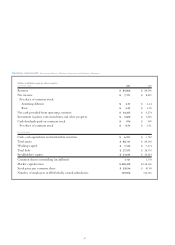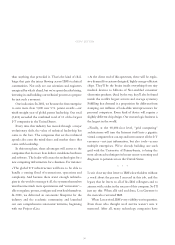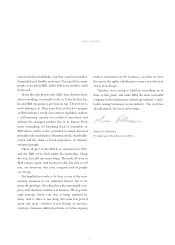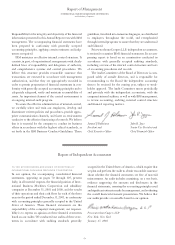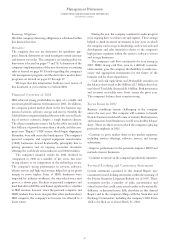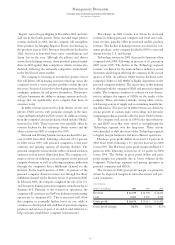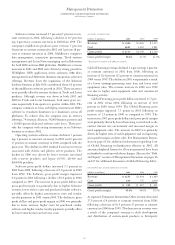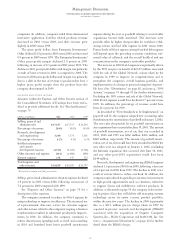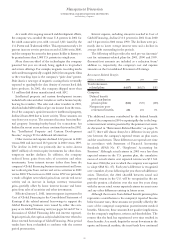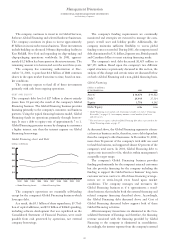IBM 2001 Annual Report Download - page 58
Download and view the complete annual report
Please find page 58 of the 2001 IBM annual report below. You can navigate through the pages in the report by either clicking on the pages listed below, or by using the keyword search tool below to find specific information within the annual report.
56
Management Discussion
INTERNATIONAL BUSINESS MACHINES CORPORATION
and Subsidiary Companies
Financing Obligations
All of the company’s financing obligations are disclosed within
this financial section.
Derivatives
The company does not use derivatives for speculative pur-
poses. Instead, derivatives are used to mitigate certain currency
and interest rate risks. The company’s accounting policy for
derivatives is located on pages 77 and 78. A discussion of the
company’s implementation of the new derivatives accounting
rules is located on page 80. Details regarding the company’s
risk management programs and the derivatives used in these
programs are located on pages 85 through 87.
We hope that this information facilitates your review of
this document as you continue to evaluate IBM.
Financial Overview of 2001
IBM achieved strong profitability in spite of a volatile and
uncertain global business environment in 2001. In addition,
the company gained market share in the key business seg-
ments of services, software, storage and servers. Notably, the
Global Services segment finished the year with a record back-
log of services contracts, despite a tough business climate.
The zSeries mainframe servers, led by the z900, recorded its
first full year of growth in more than a decade, and the com-
pany’s new “Regatta” UNIX servers, which began shipping in
December, were sold out in the fourth quarter. The company’s
personal computer and original equipment manufacturer
(OEM) businesses slowed dramatically, principally due to
pricing pressures and an ongoing economic downturn
affecting the worldwide semiconductor and OEM markets.
The company’s financial results for 2001 declined in
comparison to 2000 in a number of key areas, but were
strong relative to its competitors in the technology sector.
The company’s strong performance in services, software,
zSeries servers and high-end storage helped its gross profit
margin to move higher. Some of IBM’s businesses were
impacted by industry weakness; the microelectronics unit
grew at a slower pace. Declines in personal computers and
hard disk drives (HDD) contributed significantly to a decline
in IBM revenue, however, since the personal computer and
HDD markets have lower margins than other markets where
IBM competes, the company’s net income was affected to a
lesser extent.
During the year, the company continued to make progress
in its ongoing drive to reduce cost and expense. These savings
helped to fund increased investment in key areas in which
the company can leverage its leadership, such as research and
development and sales initiatives relative to the company’s
high priority segments within the services, software, servers
and storage businesses.
The company’s cash flow continued to be very strong in
2001. IBM’s strong cash flow, even in a difficult economic
environment, gave the company the flexibility to make nec-
essary and appropriate investments for the future of the
business and for share repurchases.
Cash and cash equivalents and Marketable securities on
the balance sheet stand at $6.4 billion, $2.7 billion above last
year’s level. Total debt decreased $1.4 billion. Both inventories
and accounts receivable were lower versus the prior year.
The company’s balance sheet remains strong.
Focus Items in 2002
Business conditions remain challenging as the company
enters the new year. The company will continue to benefit
from its business model with a mix of annuity-like businesses
and transaction-based businesses as well as its healthy balance
sheet. There are three areas in which the company is placing
particular emphasis in 2002:
•Continue to grow market share in key market segments,
including services offerings, software, servers, and storage
subsystems.
•Improve performance in the personal computer, HDD and
microelectronics businesses.
•Continue to execute on the company’s productivity initiatives.
Forward-Looking and Cautionary Statements
Certain statements contained in this Annual Report may
constitute forward-looking statements within the meaning of
the Private Securities Litigation Reform Act of 1995. These
statements involve a number of risks, uncertainties and
other factors that could cause actual results to be materially
different, as discussed more fully elsewhere in this Annual
Report and in the company’s filings with the Securities and
Exchange Commission, including the company’s 2001 Form
10-K to be filed on or about March 11, 2002.




